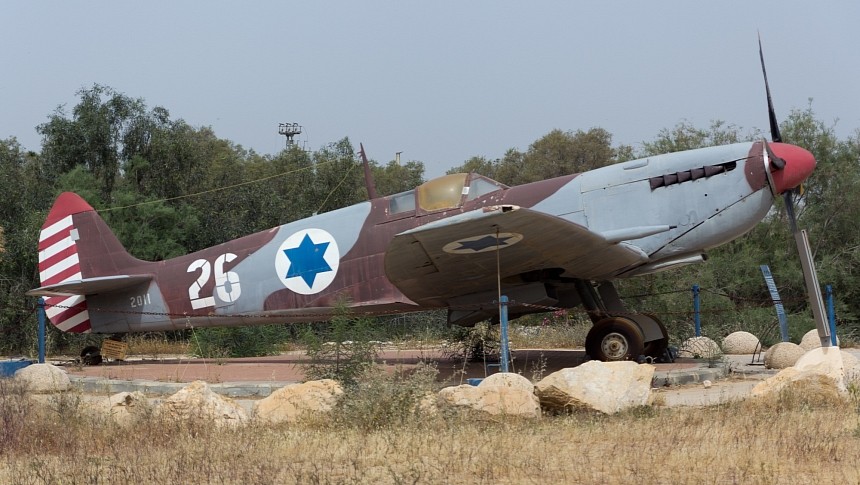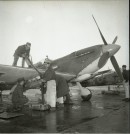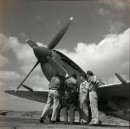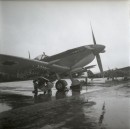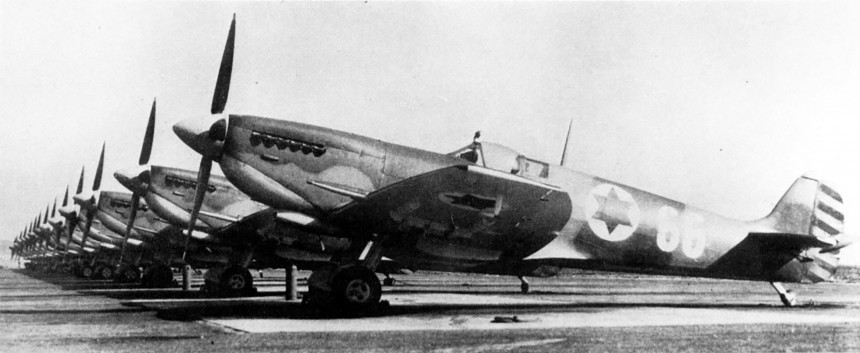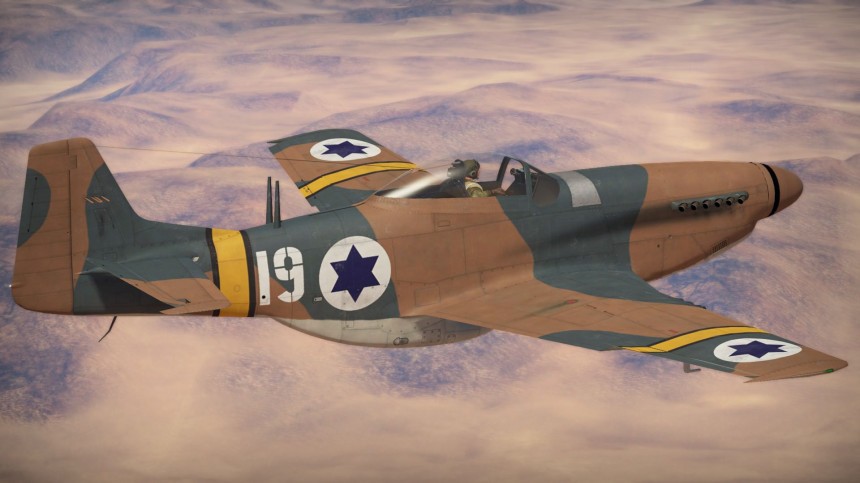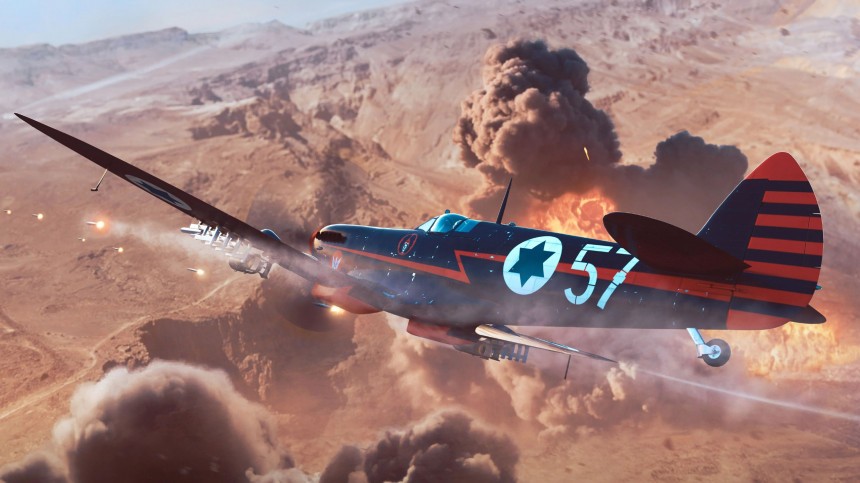They say the howl of a Rolls-Royce/Packard Merlin V12 from both the British Spitfire and the American P-51 Mustang is like listening to the essence of freedom itself. But outside their exploits bringing the fight to German Messerschmitts and Japanese Zeroes, the story of the Mustang and Spitfire didn't end after V-J Day. Both flagship fighters had another lesser-known but no less heroic story to tell in the hands of a new nation, a Jewish nation.
The story of how the fledgling Israeli state got its hands on Britain and America's favorite piston fighters is one of long odds and geo-political chess play that'd define the Middle East for the next 80 years. At a time when the fledgling Israeli state was at odds with its neighbors in the former British Mandate of Palestine, the newly founded Israeli Air Force needed front-line fighters to repel existential threats to the new state's existence.
But there was a problem. The United States, Great Britain, the Soviets, and the United Nations at large may have recognized the new Jewish state as legitimate. But as a precaution aimed at preventing the spread of unmitigated war throughout the Middle East, many countries across the future NATO and Warsaw Pact refused to provide weapons, supplies, or personnel to the Israelis during the 1948 Arab-Israel War. In the case of the United States, this embargo applied to not just the Israelis but the Arab nations as well. Going into effect on May 14th, 1948, the day before the official start of the war.
On that day, it appeared despite the unanimous approval of the Jewish state by the global powers, Israel seemed destined to be all on its own as far as military support was concerned. Had this been the case, the prospects of facing off against Jordan, Syria, Egypt, Lebanon, Iraq, and Saudi Arabia without foreign aid seemed almost insurmountable. But the very same month, in May 1947, Czechoslovakia, whose Jewish population was nearly decimated during World War II, finally broke the deadlock and agreed to commence the shipment of rifles and ammunition to Israel.
Among these first Czechoslovak imports of weapons and supplies under Operation Velvetta were crates filled with approximately 80 to 90 aircraft. Among them were Czechoslovak Avia S-999 single-engine fighters based on the German Bf-109, but also between 50 and 61 pre-owned, ex-Chechoslovak Air Force Spitfire Mk IXs (type 361s) procured directly from the Royak Aur Force. At least a dozen spare Rolls-Royce Merlin V12 engines were also supplied to power the planes in the short term. The aircraft and all the accompanying hardware soon left Czechoslovakia bound for Israel.
With permission from the Yugoslav Prime Minister Josip Broz Tito, an abandoned Luftwaffe airbase in modern-day Montenegro became a fitting way-station for the transaction between the Czechs and the Israelis to take place away from the watchful eyes of the British, Soviets, and Americans. No sooner did the planes arrive, either disassembled in trucks or flown in from an airfield in the Town of Zatec in the modern-day Czech Republic, did these Avias and Spitfires commence combat against attacking Arab Air Forces. To the dismay of all Israeli pilots, their opposing Air Forces, particularly that of Egypt, employed Mk.IX Spitfires in their arsenals during the war as well.
As Israeli Avias and Spitfires engaged Arab Spitfires and Hawker Hurricanes, the skies above the former Mandate of Palestine looked much the same as Europe and the Pacific just a few years earlier. But victory was still not assured for Israel by the summer of 1948. With the Administration of Harry S. Trueman still stonewalling all but humanitarian aid to Israel, other unofficial methods were needed to get American planes into the hands of Israeli Air Force pilots. Without the help of powerful and influential forces inside the Jewish-American diaspora, American P-51 Mustangs would have probably never seen Israeli soil during the 1948 War.
According to the Jewish Virtual Library Organization, a non-profit organization detailing online records on ancient and modern Jewish history, American Jews situated around New York, California, and South Florida, were all too happy to help. Using clever strictly-private market methods to certify four North American P-51D Mustangs as agricultural equipment. Among the American citizens who helped coordinate these intricate transactions included the future founder of Israel Aerospace Industries, a New York City native named Al Schwimmer. With the paperwork all in order, the first batch of Mustangs left American ports and touched down on Israeli soil in crates in September 1948.
To say the balance of power in the skies over the former Mandate changed in Israel's favor upon the Mustang's arrival wouldn't be much of an overstatement. With superior range compared to the Avia S-199 and the Spitfire, Mustangs could conduct deep strike missions against Egyptian, Syrian, and Jordanian bombers and ground assets and return home to base on a single tank of fuel. Ironically, British RAF de Havilland Mosquito pilots who'd flown uninterrupted during the conflict conducting reconnaissance were unaware of the Israeli acquisition when one became the first casualty of an IAF Mustang.
By January 1949, Israeli P-51s were engaging Egyptian pilots in Italian Macchi C.205 Veltro fighters in some of the final air-to-air engagements before Israeli victory in March 1949. Before the end of the fighting, further American aircraft like Douglas C-47 Skytrains and B-17 Flying Fortresses also arrived on the scene using the same private-sector workarounds subverting restrictive American arms embargos. Between the Spitfire and later the Mustang, the IAF became the most feared aerial fighting force in the Middle East. With the British and American arms embargo dissolving after the war, Israel was free to purchase Western equipment in an official capacity at last.
This caused the defeated Arab nations to often prefer Soviet airplanes, tanks, and equipment for this very reason. Even as more advanced turbojet aircraft like Gloster Meteors and Dassault Mysteres padded an already impressive Israeli Air Force, Spitfires and Mustangs continued to serve under the new David Ben-Gurian-run government into the 1950s and the Suez Crisis. During this conflict, Israeli Mustangs conducted daring low-altitude communication line-cutting missions that drastically reduced the Egyptian capacity to wage war.
The last P-51D flight over Israel in an official Air Force capacity took place in January 1961. Meanwhile, reserves of Mk.IX Spitfires were mainly sold to the Burmese Air Force in 1954 before the remainder left service sometime in the late 1950s. During their service, the two Merlin-powered warbirds gave rise to some of Israel's first fighter aces. Though not an ace himself, one particular matte-black painted Spitfire during the war was piloted by a man called Ezer Weisman.
After rising to become a member of the Israeli Parliament, its National Defense Minister, and finally, its seventh President, "Weizman's Black Spit," as it was known, became a national symbol of Israeli pride. The famous warbird even conducted a flyover at Weizman's state funeral in 2005. Today, four Israeli P-51 Mustangs and three Spitfires, including Weizman's Black Spit, are on display at the Israeli Air Force Museum on the sight of the Hatzerim IAF Airbase in the Negev Desert.
On December 14th, 2021, the Israeli P-51D and Spitfire became playable aircraft in Gaijin Entertainment's smash-hit vehicle combat game War Thunder under the "Winged Lions" update. With an air-realistic battle rating of 4.3 for both aircraft, Weizman's Black Spit even appears as a premium DLC aircraft.
Though often criticized for not featuring enough bespoke Israeli aircraft, it was no less exciting to see two of history's favorite warplanes flying the colors of a nation that fought for their right to exist. More to the point, without the North American P-51 Mustang and the Supermarine Spitfire, there might not be the modern nation of Israel today. For this reason, we owe these two warbirds our deepest thanks all over again.
But there was a problem. The United States, Great Britain, the Soviets, and the United Nations at large may have recognized the new Jewish state as legitimate. But as a precaution aimed at preventing the spread of unmitigated war throughout the Middle East, many countries across the future NATO and Warsaw Pact refused to provide weapons, supplies, or personnel to the Israelis during the 1948 Arab-Israel War. In the case of the United States, this embargo applied to not just the Israelis but the Arab nations as well. Going into effect on May 14th, 1948, the day before the official start of the war.
On that day, it appeared despite the unanimous approval of the Jewish state by the global powers, Israel seemed destined to be all on its own as far as military support was concerned. Had this been the case, the prospects of facing off against Jordan, Syria, Egypt, Lebanon, Iraq, and Saudi Arabia without foreign aid seemed almost insurmountable. But the very same month, in May 1947, Czechoslovakia, whose Jewish population was nearly decimated during World War II, finally broke the deadlock and agreed to commence the shipment of rifles and ammunition to Israel.
Among these first Czechoslovak imports of weapons and supplies under Operation Velvetta were crates filled with approximately 80 to 90 aircraft. Among them were Czechoslovak Avia S-999 single-engine fighters based on the German Bf-109, but also between 50 and 61 pre-owned, ex-Chechoslovak Air Force Spitfire Mk IXs (type 361s) procured directly from the Royak Aur Force. At least a dozen spare Rolls-Royce Merlin V12 engines were also supplied to power the planes in the short term. The aircraft and all the accompanying hardware soon left Czechoslovakia bound for Israel.
As Israeli Avias and Spitfires engaged Arab Spitfires and Hawker Hurricanes, the skies above the former Mandate of Palestine looked much the same as Europe and the Pacific just a few years earlier. But victory was still not assured for Israel by the summer of 1948. With the Administration of Harry S. Trueman still stonewalling all but humanitarian aid to Israel, other unofficial methods were needed to get American planes into the hands of Israeli Air Force pilots. Without the help of powerful and influential forces inside the Jewish-American diaspora, American P-51 Mustangs would have probably never seen Israeli soil during the 1948 War.
According to the Jewish Virtual Library Organization, a non-profit organization detailing online records on ancient and modern Jewish history, American Jews situated around New York, California, and South Florida, were all too happy to help. Using clever strictly-private market methods to certify four North American P-51D Mustangs as agricultural equipment. Among the American citizens who helped coordinate these intricate transactions included the future founder of Israel Aerospace Industries, a New York City native named Al Schwimmer. With the paperwork all in order, the first batch of Mustangs left American ports and touched down on Israeli soil in crates in September 1948.
To say the balance of power in the skies over the former Mandate changed in Israel's favor upon the Mustang's arrival wouldn't be much of an overstatement. With superior range compared to the Avia S-199 and the Spitfire, Mustangs could conduct deep strike missions against Egyptian, Syrian, and Jordanian bombers and ground assets and return home to base on a single tank of fuel. Ironically, British RAF de Havilland Mosquito pilots who'd flown uninterrupted during the conflict conducting reconnaissance were unaware of the Israeli acquisition when one became the first casualty of an IAF Mustang.
This caused the defeated Arab nations to often prefer Soviet airplanes, tanks, and equipment for this very reason. Even as more advanced turbojet aircraft like Gloster Meteors and Dassault Mysteres padded an already impressive Israeli Air Force, Spitfires and Mustangs continued to serve under the new David Ben-Gurian-run government into the 1950s and the Suez Crisis. During this conflict, Israeli Mustangs conducted daring low-altitude communication line-cutting missions that drastically reduced the Egyptian capacity to wage war.
The last P-51D flight over Israel in an official Air Force capacity took place in January 1961. Meanwhile, reserves of Mk.IX Spitfires were mainly sold to the Burmese Air Force in 1954 before the remainder left service sometime in the late 1950s. During their service, the two Merlin-powered warbirds gave rise to some of Israel's first fighter aces. Though not an ace himself, one particular matte-black painted Spitfire during the war was piloted by a man called Ezer Weisman.
After rising to become a member of the Israeli Parliament, its National Defense Minister, and finally, its seventh President, "Weizman's Black Spit," as it was known, became a national symbol of Israeli pride. The famous warbird even conducted a flyover at Weizman's state funeral in 2005. Today, four Israeli P-51 Mustangs and three Spitfires, including Weizman's Black Spit, are on display at the Israeli Air Force Museum on the sight of the Hatzerim IAF Airbase in the Negev Desert.
Though often criticized for not featuring enough bespoke Israeli aircraft, it was no less exciting to see two of history's favorite warplanes flying the colors of a nation that fought for their right to exist. More to the point, without the North American P-51 Mustang and the Supermarine Spitfire, there might not be the modern nation of Israel today. For this reason, we owe these two warbirds our deepest thanks all over again.
